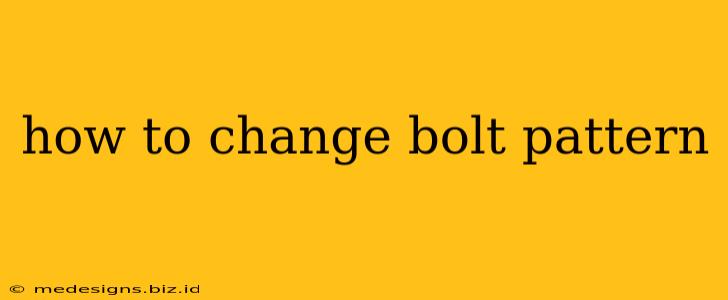Changing a vehicle's bolt pattern is a significant modification that impacts safety and performance. It's not a simple task and requires careful planning and execution. This guide details the process, highlighting crucial considerations and potential challenges. Improperly changing your bolt pattern can lead to serious accidents. Proceed with caution and consider professional assistance if you're unsure about any step.
Understanding Bolt Patterns
Before diving into the process, it's crucial to understand what a bolt pattern is. The bolt pattern, also known as the wheel bolt pattern or PCD (Pitch Circle Diameter), describes the arrangement of the wheel studs on your vehicle's hub. It's expressed as a number followed by another number – for example, 5x114.3.
- The first number represents the number of lug nuts or studs.
- The second number represents the diameter of the circle on which those studs are located. This diameter is measured in millimeters.
Finding Your Bolt Pattern: You can usually find your vehicle's bolt pattern in your owner's manual or on a sticker located inside the driver's side doorjamb. Alternatively, you can consult online resources specific to your vehicle's make and model.
The Process of Changing a Bolt Pattern
Changing a bolt pattern is a complex procedure that generally involves these steps:
1. Choosing the New Bolt Pattern and Wheels
This is the most critical step. You need to carefully select a new bolt pattern that is compatible with readily available wheels and offers the desired fitment for your vehicle. Incorrect choices here can severely compromise safety. Consider consulting with a wheel and tire specialist to ensure compatibility.
2. Hubcentric vs. Lug-Centric Wheels
Understanding the difference between hub-centric and lug-centric wheels is essential.
- Hub-centric wheels: These wheels center on the hub, providing a more precise and stable fit.
- Lug-centric wheels: These wheels center on the lug nuts/studs. While less precise, they are often more adaptable.
Choosing the right type depends on the new bolt pattern and the availability of wheels.
3. Preparing the Vehicle
This involves removing the existing wheels and thoroughly inspecting the brake calipers, suspension components, and other parts that might interfere with the new wheels. You might need to make adjustments or modifications to accommodate the larger or smaller wheels depending on your new bolt pattern.
4. Installing Wheel Adapters (Usually Necessary)
Most often, changing the bolt pattern necessitates the use of wheel adapters. These are specialized metal plates that bolt onto the existing wheel studs and provide the new bolt pattern for the new wheels. Choosing high-quality adapters is crucial for safety. Cheap or poorly made adapters can fail, leading to catastrophic consequences.
5. Mounting the New Wheels
Once the adapters are securely installed, you can mount the new wheels, ensuring they are properly tightened according to the manufacturer's specifications. Always torque the lug nuts/studs to the correct specifications; using a torque wrench is essential.
6. Testing and Alignment
After installing the new wheels, test drive the vehicle carefully, paying attention to any unusual vibrations or handling issues. A wheel alignment is highly recommended after changing the bolt pattern to ensure proper handling and tire wear.
Potential Challenges and Considerations
- Wheel Offset: This is the distance between the wheel mounting surface and the centerline of the wheel. Changing the bolt pattern might require adjustments to the wheel offset to avoid rubbing or interference with suspension components.
- Brake Caliper Clearance: Larger wheels or different offsets might interfere with the brake calipers. Modifications might be needed to ensure sufficient clearance.
- Suspension Components: Depending on the new wheel size and offset, you might need to adjust or modify suspension components.
- Cost: Changing a bolt pattern can be expensive, involving the cost of wheel adapters, new wheels, alignment, and potential modifications.
Safety First!
Changing your vehicle's bolt pattern is a significant modification with potential safety implications. If you're not comfortable with the process, it's best to seek professional assistance from a qualified mechanic or wheel and tire specialist. Improperly executed changes can lead to wheel detachment, accidents, and serious injuries. Always prioritize safety and thorough planning.
